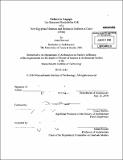| dc.contributor.advisor | Nasser Rabbat. | en_US |
| dc.contributor.author | Dawood, Azra | en_US |
| dc.contributor.other | Massachusetts Institute of Technology. Dept. of Architecture. | en_US |
| dc.coverage.spatial | f-ua--- | en_US |
| dc.date.accessioned | 2010-10-12T16:14:18Z | |
| dc.date.available | 2010-10-12T16:14:18Z | |
| dc.date.copyright | 2010 | en_US |
| dc.date.issued | 2010 | en_US |
| dc.identifier.uri | http://hdl.handle.net/1721.1/59109 | |
| dc.description | Thesis (S.M.)--Massachusetts Institute of Technology, Dept. of Architecture, 2010. | en_US |
| dc.description | Cataloged from PDF version of thesis. | en_US |
| dc.description | Includes bibliographical references (p. 231-233). | en_US |
| dc.description.abstract | In 1926, the United States' first Egyptologist James Henry Breasted and the philanthropist John D. Rockefeller Jr., proposed to build a New Egyptian Museum and Research Institute in Cairo. The Egyptian government ultimately rejected the proposal and the museum was never built as suggested. The project's failure was attributed to "suspicious" or "irrational" nationalism and "Egyptian vanity." The archives, however, demonstrate otherwise. This thesis analyzes the Breasted-Rockefeller museum's conception, trajectory and failure, using the team's lengthy correspondence. The archives show that the project was an early example of U.S. cultural imperialism, disguised as a gift of "Science," from the "Great Democracy of the West," to an Egypt desirous of independence from British and French empires. Deploying the twin themes of post World War I "opportunity" (political) and "obligation" (civilizational, scientific, philanthropic) to demonstrate the imperial possibilities of the particular political and cultural moment in 1926, Breasted mobilized Rockefeller first and the U.S. State Department later, to pry open the political field in Egypt for U.S. entry through archaeology and appropriation of antiquity. The Breasted-Rockefeller team's strategy was to create an Anglo- American alliance in the Near East, by beginning with the creation of a private-philanthropic corporation for the New Egyptian Museum, controlled by Western archaeologists, with token Egyptian representation. This ambitious and innovative approach to imperialism was spatially and architecturally revealed in the proposed museum's design and in its location in Cairo. That this project failed when it would succeed in later iterations elsewhere, is to be ascribed both to the lack of U.S. power against competing British and French imperialisms at this early stage, as well as to Egyptian nationalism, which identified the Breasted-Rockefeller proposal for the imperial project that it was, and which had begun to recognize Egyptian antiquity as a metaphor for nationalism. | en_US |
| dc.description.statementofresponsibility | by Azra Dawood. | en_US |
| dc.format.extent | 233 p. | en_US |
| dc.language.iso | eng | en_US |
| dc.publisher | Massachusetts Institute of Technology | en_US |
| dc.rights | M.I.T. theses are protected by
copyright. They may be viewed from this source for any purpose, but
reproduction or distribution in any format is prohibited without written
permission. See provided URL for inquiries about permission. | en_US |
| dc.rights.uri | http://dspace.mit.edu/handle/1721.1/7582 | en_US |
| dc.subject | Architecture. | en_US |
| dc.title | Failure to engage : the Breasted-Rockefeller gift of a new Egyptian Museum and Research Institute at Cairo (1926) | en_US |
| dc.title.alternative | Breasted-Rockefeller gift of a new Egyptian Museum and Research Institute at Cairo (1926) | en_US |
| dc.title.alternative | Breasted-Rockefeller gift for a new Egyptian Museum and Research Institute at Cairo (1926) | en_US |
| dc.type | Thesis | en_US |
| dc.description.degree | S.M. | en_US |
| dc.contributor.department | Massachusetts Institute of Technology. Department of Architecture | |
| dc.identifier.oclc | 657335753 | en_US |
